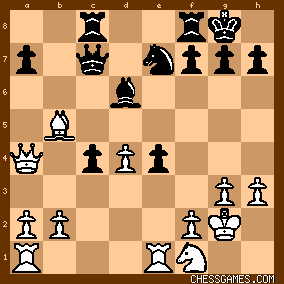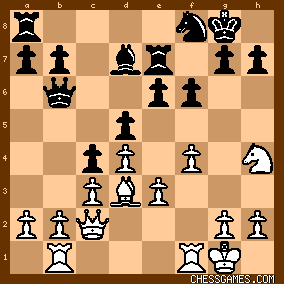|
< Earlier Kibitzing · PAGE 2 OF 2 ·
Later Kibitzing> |
| Nov-26-09 | | TheBish: The combination by White (Banks) is unsound! I was wondering why Kashdan (Black) didn't play 31...Qg6!!, forking rook and pawn. I thought this was good enough to draw, but Black is actually winning this! I put it on the computer to confirm. 31...Qg6! and now:
A) 32. Rf1 Kh4+! 33. Kh1 Qe4+ 34. Kg1 Kh3! 35. Kf2 (or 35. Rf2 Qg4+ 36. Kf1 Qd1#) exd4! (threatening Qe3#) 36. cxd4 Qe7! and wins the f-pawn next move, since 37. Kg1 loses quickly to 37...Qe2! 38. Rf2 Qg4+ and 39...Qd1+, mating. B) 32. f8=Q Qxb1+ 33. Kg2 (33. Qf1 Qxf1+ 34. Kxf1 exd4 35. cxd4 Kf4 is a simple endgame for Black) Qxb2+ 34. Kf1 Qb1+ 35. Kg2 Qg6 36. dxe5 Qe4+ 37. Kg1 Qxe5 and Black is up a pawn and should probably eventually win. So White should have at least drawn this! |
|
| Nov-26-09 | | SPINK: nice queen sac in this one, plus the calculation of the endgame after 38. e7 |
|
| Nov-26-09 | | moi: <TheBish> Thanks for this nice analysis :) If one has a queen for material or position, one should look for targets for the queen. |
|
| Nov-26-09 | | Once: <TheBish> <RV> Good call! I think you are both right. 31...Qg6, allowing f8, seems to give black at least an edge (and certainly not a certain loss). A random thought - should we say that willingly allowing a pawn promotion is the same as a queen sacrifice? In either case, you are altering the material imbalance by one whole queen. |
|
| Nov-26-09 | | JohnBoy: Agreed, <once>. Allowing a pawn promotion is kind of a double negative (added queen = negative sacrifice, other player = second negative) sacrifice for a tempo. |
|
| Nov-26-09 | | bengalcat47: Newell Banks was a master of the game of draughts, or checkers as we know it here in the US. On occasion he ventured into chess and was proficient at the game, but his main skill was in checkers. He gave numerous blindfold checkers exhibitions and was skilled at blindfold play. An excellent out-of-print book about Banks is his own book, Banks' Blindfold Checker Masteepieces. Seeing Banks' name, one cannot help but think of another famous chess master who was skilled at checkers and regularly gave blindfold exhibitions at both games, namely Harry Nelson Pillsbury! |
|
| Nov-26-09 | | technical draw: Ouch! That pun hurts... |
|
| Nov-26-09 | | RandomVisitor: 22.c4! dxc4 and now white has a good game:
1: Lewis J Isaacs - Newell William Banks, Chicago 1926 1926

click for larger viewAnalysis by Rybka 3 : <20-ply> <1. ± (0.91): 23.Rac1> a5 24.Bxc4 Qb7 25.Qb5 Qxb5 26.Bxb5 Rb8 27.a4 f5 28.Re2 Bb4 29.Rc7 Rbd8 30.Nd2 Rxd4 31.Nb3 Rd1 32.Bc4+ Kh8 33.Nxa5 Ra1 34.Bb5 2. ± (0.87): 23.Ne3 Rb8 24.Rac1 a5 25.Rc2 Rfd8 26.Bxc4 Rb4 27.Qa3 Qa7 28.Qc3 |
|
| Nov-26-09 | | WhiteRook48: nice sacrifice |
|
| Nov-26-09 | | Cordeiro: I'd like to have always the GREEN board option. It's the BEST. |
|
Nov-26-09
 | | An Englishman: Good Evening: My, oh my, 31...Qg6 is a remarkable defensive resource; my old weakness in tactics raises its ugly head again. Of course, Kashdan didn't see it, either, so perhaps I can take some small consolation in that. |
|
Sep-07-15
 | | al wazir: In the game as played, white missed an easier win with 36. h4, followed by h5+, e7, and f8=Q. But 31...Qg6! is a real eye-opener (see <TheBish>'s analysis above). |
|
| Sep-07-15 | | gofer: What's so wrong with <16 ... c4>?
click for larger view |
|
| Sep-07-15 | | LeilaDog: Nothing, I think, gofer. Indeed, 16..Bb5 looks good to me. Be8 did look rather passive. Also, just agreeing with TheBish's analysis above. I think however white can just about cling onto a draw even with the pawn down, but its moves have to be immaculate. |
|
Sep-07-15
 | | Richard Taylor: The combination is unsound (checked it on Komodo) as said above but is was ingenious. It is easy to see a brilliancy and, in the excitement forget to check all the defender's resources. But a lot of similar combinations are unsound I win a lot of games with dubious but testing things like that [blitz games online] (mind you I also lose a hell of a lot myself on a bad day esp. when I am tired) often because the opponent thinks they have no resource. I had a game tonight (OTB at my club) I was convinced I had a winning game but checking the computer, I only had just equal. I had also missed the defence to a combination I didn't play, not because of missing that, but because I (mistakenly) thought I was in a much better position. Then I blundered. However, that is how chess goes at club level for most of us. But sometimes you get lucky! So it was a nice one by Banks here! Luck and the clock time plays a big part in chess. |
|
Sep-07-15
 | | Richard Taylor: I have a book about great master players by Kashdan, it was my fathers, we had it since about 1963 I think. Good book. |
|
| Sep-07-15 | | morfishine: <Richard Taylor> Enjoyable post(s) as usual; and so true about chess at the club level. One of the funnest times I've had at the club was the monthly rapid tournament. Everybody is clumped together so a 1500-rated player may play a 2300 player. But at 15-min time controls, its astounding how this levels the playing field. Once I snatched a pawn right out of the opening from a 2400 player (he blundered by pinning my Knight with Bg4 but neglected to play Nf6 first, so after I played Nxe5, he could only take the Knight and I followed with Qxg4 winning a pawn) who could only look glumly on as I built a K-side attack; But then I hung a piece and lost :( Rapid format seems to cause higher-rated players to blunder more, which is great for us below 2000. Once, I was being crushed by a 2100 player, but found a counter smothered threat that forced a repetition and draw. He was irked, particularly when I did almost the exact same thing to him again in the next month rapids. That was fun, I wasn't a very good matchup for him :) Those were the days
***** |
|
| Sep-07-15 | | hkannan2000: <TheBish> This amazing combination is worth preserving. How important not to lose your nerves in critical positions. Thanks. |
|
| Sep-07-15 | | jith1207: <Banks Kashed-in!> |
|
| Sep-07-15 | | The Kings Domain: Nice, a game from The Jazz Age. Simple and steady game, black blundered on his kingside affording white the advantage. |
|
| Sep-07-15 | | RookFile: Pretty game. |
|
| Sep-08-15 | | savagerules: You can tell Banks was a checkers players in this game by the way he put his pawns and pieces on dark squares in the opening - of course in checkers only the dark squares are used. |
|
| Sep-08-15 | | kevin86: White uses the outside passed pawn to win. The rook pawn can WIN because black's king is absent. |
|
Sep-09-15
 | | Richard Taylor: <morphishine> Do you mean you had a mate threat when you took the pawn. That can happen as it isn't a 'true pin'...yes it happens more in Rapid, I drew with two FM players both ca. 2300 in a Rapid. Actually I had a win, those two draws, then, in the next rounds it suddenly hit me how tired I was and I overlooked a mate in 1 versus a sharp player who is over 2100, but with whom I had a draw after a long complex game once when he essayed a Centre-Counter...I played an exchange sacrifice which was sound but got lost in the complications, later he missed a way to go into a won ending. But in the Rapid tourney I had set off about 5 am and as I normally sleep in late, I suddenly felt really tired after lunch about 1 am and bombed out. My draw against FM Bob Smith was interesting as I sacrificed the exchange and had I played it right I was winning. He always used to use the Canal Attack (setting up a Maroczy, I also use similar Maroczys if I think my opponent likes complications etc, in fact I did that to beat a 2000 player last week) to shut down my (and others') Najdorf, and I broke out with a d5. One of the few games I was able to. But I have to say that in OTB Standard games Smith is very good. Sarapu I recall actually saying it was good to take Smith to the Olympiads. He was good at drawing with GMs if not beating some (he may not have won but a draw against a GM is pretty useful!) The NZ Open is, well it is open (but not Rapid) to anyone so that in Rd One I was playing GM Allan Stig Rasmussen and I reached a winning position with him only having sometimes less than 1 minute. Unfortunately I couldn't offer a draw as it wasn't allowed on the top 10 boards until move 30, and I went wrong in the excitement of it all... But next round I was playing someone rated 900 or so. I won, but I will say this, regardless of rating I was very careful right to the end. But what I did well in that tourney was to be more positive when I lost. For example, I lost (played badly) playing the black side of the Nimzo, but then a few games later I found a better way of playing that opening and drew with Wayne Power who is no mug, and in fact an ex-NZ Champion competitor (when it was a round robin system)...so that was the result of being practical and not folding if I lost, and in fact going back into the same opening with a better plan...so overall I acheived 50% which is good. Already the NZ Open starting Jan 2 2016 has 6 GMs playing and some IMs etc I might play again. |
|
| May-05-19 | | thegoodanarchist: After 34.e6, it's time for Black to exit through the gift shop. |
|
 |
|
< Earlier Kibitzing · PAGE 2 OF 2 ·
Later Kibitzing> |





































